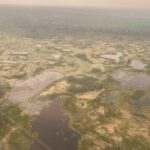Last April, Prince George’s County became the first county in Maryland to effectively ban hydraulic fracturing within its borders. Local lawmakers voted unanimously to prohibit the practice, which involves pumping pressurized water and chemicals into the ground to crack the underlying shale rock and release a valuable mixture of natural gasses that can be burned to produce energy.
While fracking technology has been around since the 1940’s, the United States has only recently seen a boom in the natural gas industry. The uptick in natural gas extraction has brought with it considerable controversy surrounding the potential environmental impacts that come with the drilling process, such as methane leaks and groundwater contamination.
The Obama administration released a series of detailed regulations for hydraulic fracturing in 2015 as a part of the President’s Climate Action Plan, to help account for this potential harm. That same year, a federal court ruling blocked the regulations, stating that new permitting rules could only be issued through a congressional vote. The proposed regulations would only apply to drilling operations taking place on federal lands, which produce 11% of the natural gas consumed in the U.S., according to government data. For sites located on state-owned and private land, states would maintain control over regulatory actions.
In Maryland, Governor Larry Hogan has allowed the instatement of a statewide moratorium on hydraulic fracturing until October 2017. The moratorium was established to allow time for the Maryland Department of the Environment and the Department of Natural Resources to determine the environmental and economic impact of hydraulic fracturing and to devise a series of regulations. Once the moratorium expires, counties across the state will be given the chance to engage in fracking.
Dr. Melissa A. Kenney, an Assistant Research Professor in Environmental Decision Analysis at the University of Maryland, explains that with any policy decision that could potentially affect the environment, monitoring is crucial to the assessment of impacts.
“Part of the challenge, if fracking is implemented, is being able to have causal linkages from a particular impact to the act of fracking,” Kenney says. “It is critical to collect data on a range of environmental conditions before fracking occurs to have baseline information which can be used to assess if mitigation is necessary to correct for any damages. If there is any possibility that fracking is an option in Maryland, we should start collecting data now.”
While Prince George’s County has already declared a ban on fracking, the vote may have been more of a statement than an actual policy decision. That’s because the amount of natural gas that lies beneath the county is almost negligible. In places like Allegany and Garrett Counties, however, the underlying natural gas is connected to the massive Marcellus Shale formation, which is the largest onshore natural gas reserve in the United States. Lawmakers in both of these counties seem poised to allow the practice once the moratorium expires.
While the political battle can be divided amongst individual counties, the potential environmental and economic impacts are more far-reaching. Dr. Fernando Miralles-Wilhelm, a hydrologist who has worked as a principal investigator in research sponsored by NASA, NOAA, the World Bank and other agencies, explains that resources like water and natural gas cannot be confined to county lines.
“This is not a county issue,” Miralles-Wilhelm says. “It’s one of these situations in which you have a resource that is common pool and you can’t really fragment the decision. You could have one county deciding to do it, and it could potentially impact all of the counties around it.”
The potential for statewide ramifications makes the regulation of drilling all the more important. For Miralles-Wilhelm, the decision comes down to an evaluation of the economic gains of obtaining an energy resource and the financial burdens of dealing with environmental disruption.
“You have to try to figure out the potential impact scenarios, quantify them economically, and then factor that into a decision. All cost-benefit analyses that benefit the fracking argument don’t consider the environmental damages very explicitly,” Miralles-Wilhelm contends. “Having one county ban it is a positive sign environmentally speaking, but it won’t be enough unless others agree or follow the same trend. We have every county trying to do something different, at the end of the day it won’t really matter because it’s really one resource that’s under there.”






